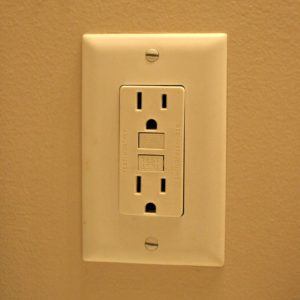Electrical fires are one of the most common causes of house fires, and they can be devastating. Not only can they destroy your home, but they can also put your loved ones in danger. As a homeowner, it’s your responsibility to take steps to protect your home and family from electrical hazards. One of the most important safety measures is having GFCI outlets and surge protectors installed. These devices can save your home from potential electrical hazards, especially when it comes to protecting your lamps.
What are GFCI outlets and how do they work?
GFCI stands for ground-fault circuit interrupter. It is a special type of electrical outlet that is designed to protect you from electrical shock. GFCI outlets work by constantly monitoring the electrical current flowing through a circuit. If the outlet detects a change in the current, it will shut off power to the circuit. This can happen in as little as 1/40th of a second, which is fast enough to prevent electrocution.
GFCI outlets are typically installed in areas where there is a high risk of electrical shock, such as bathrooms, kitchens, and outdoor areas. They are required by law in many areas, and for good reason. According to the National Electrical Code, GFCI outlets should be installed in all areas within six feet of a sink or water source. This is because water is a great conductor of electricity, and even a small amount of water can increase the risk of electrical shock.
The importance of GFCI outlets in protecting your home lamps
While GFCI outlets are essential for protecting you from electrical shock, they are also important for protecting your home lamps. Lamps are often used in areas where there is a high risk of water exposure, such as bathrooms and kitchens. If a lamp is plugged into a regular electrical outlet in one of these areas, it could pose a serious electrical hazard.
For example, if you accidentally knock over a lamp while it’s plugged in, the water could cause the lamp to short-circuit. This could lead to a fire or electrical shock. However, if the lamp is plugged into a GFCI outlet, the outlet will shut off power to the circuit before any damage can occur.
What are surge protectors and their role in protecting electronics?
A surge protector is a device that is designed to protect your electronics from power surges. Power surges can occur when there is a sudden increase in the electrical current flowing through a circuit. This can happen for a variety of reasons, such as lightning strikes or power outages.
When a power surge occurs, it can damage or destroy your electronics. This is because the sudden increase in electrical current can overload the circuitry of your electronics, causing them to fail. Surge protectors work by diverting the excess electrical current away from your electronics and into the ground.
The difference between GFCI outlets and surge protectors
While GFCI outlets and surge protectors are both designed to protect you from electrical hazards, they serve different purposes. GFCI outlets are designed to protect you from electrical shock, while surge protectors are designed to protect your electronics from power surges.
GFCI outlets are typically installed in areas where there is a high risk of water exposure, such as bathrooms, kitchens, and outdoor areas. Surge protectors are typically used to protect electronics that are sensitive to power surges, such as computers, televisions, and gaming consoles.
How to choose the right GFCI outlet and surge protector for your home lamps
When it comes to choosing the right GFCI outlet and surge protector for your home lamps, there are a few things to keep in mind. First, make sure that the GFCI outlet and surge protector are compatible with your lamps. This means that they should be rated for the correct voltage and amperage.
Second, consider the location where the lamps will be used. If the lamps will be used in an area where there is a high risk of water exposure, such as a bathroom or kitchen, make sure that the GFCI outlet is installed within six feet of a sink or water source.
Finally, consider the type of surge protector you need. There are many different types of surge protectors available, ranging from basic models to advanced models with multiple outlets and USB ports. Choose a surge protector that meets your specific needs and budget.
Installation tips for GFCI outlets and surge protectors
Installing GFCI outlets and surge protectors can be a bit tricky, especially if you’re not familiar with electrical work. If you’re not comfortable with electrical work, it’s important to hire a licensed electrician to do the job for you.
If you do decide to install GFCI outlets or surge protectors yourself, make sure that you follow the manufacturer’s instructions carefully. This will ensure that the devices are installed correctly and will function properly.
Maintenance of GFCI outlets and surge protectors
Once your GFCI outlets and surge protectors are installed, it’s important to maintain them properly. This means testing your GFCI outlets regularly to make sure that they are functioning properly. To test a GFCI outlet, simply press the “test” button on the outlet. The outlet should shut off power to the circuit. To reset the outlet, press the “reset” button.
Surge protectors don’t require regular testing, but they should be replaced every few years. This is because the components in surge protectors can degrade over time, reducing their effectiveness.
Other ways to protect your home lamps
In addition to GFCI outlets and surge protectors, there are other steps you can take to protect your home lamps. For example, you can use LED light bulbs instead of incandescent bulbs. LED bulbs produce less heat, which reduces the risk of fire.
You can also avoid using extension cords whenever possible. Extension cords can overload circuits, increasing the risk of electrical hazards. If you do use extension cords, make sure that they are rated for the correct voltage and amperage.
Conclusion
GFCI outlets and surge protectors are essential for protecting your home and loved ones from electrical hazards. By understanding how these devices work and why they are important, you can take steps to keep your home lamps and entire home safe. Remember to choose the right GFCI outlet and surge protector for your needs, install them properly, and maintain them regularly. With these simple steps, you can power up your home’s safety game and enjoy peace of mind knowing that you’re protected from electrical hazards.
Click to Learn More!


